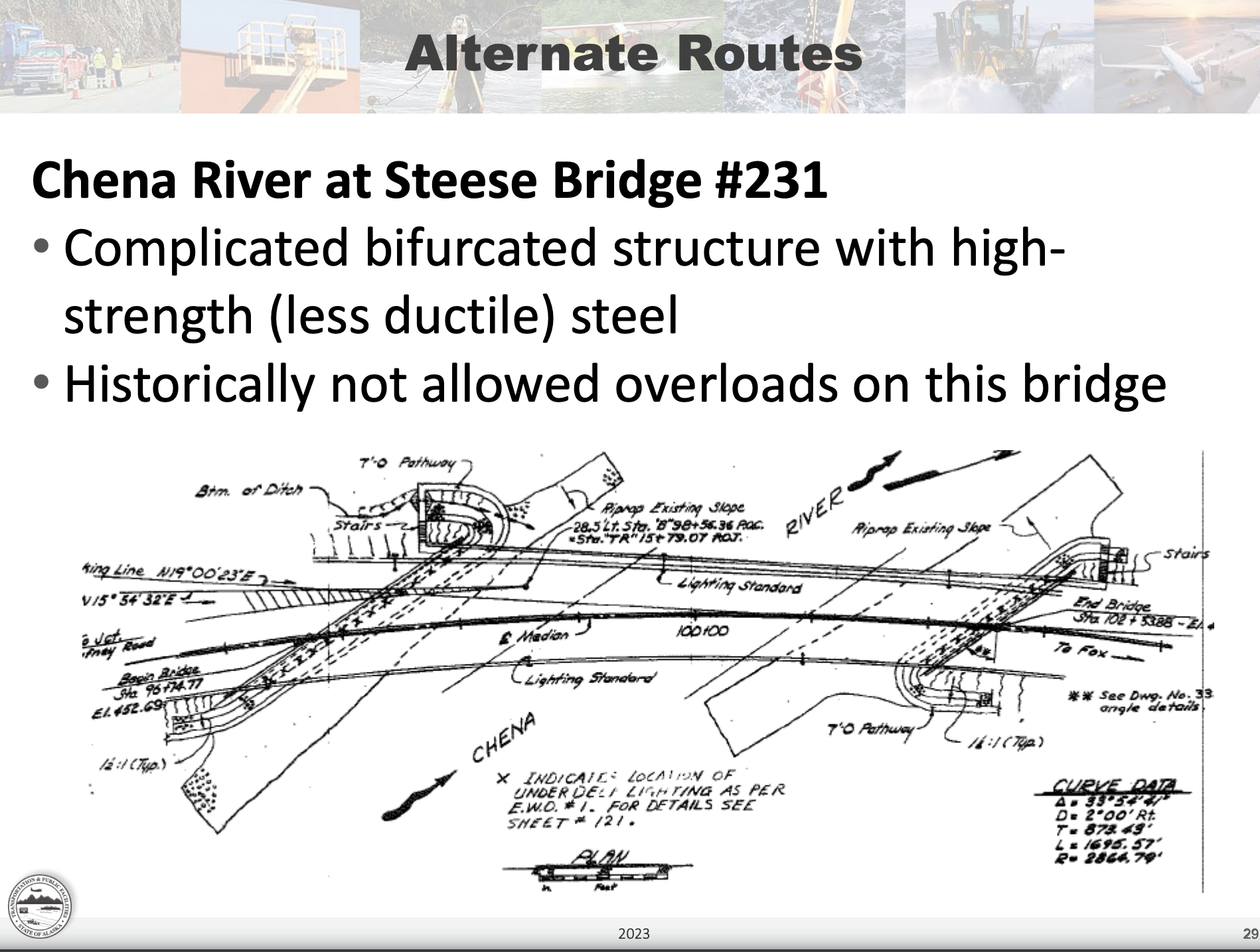Kinross tells court it will change Fairbanks route for its trucks. But chief state bridge engineer warns against using Steese bridge for 'heavy ore loads'
As I’ve written here before, state regulations on oversize trucks do not allow Kinross to use the Mitchell Expressway-Peger Road-Johansen Expressway route through Fairbanks.
The regulatory conflict is one of the key elements in the lawsuit filed by the Committee for Safe Communities against the state.
In an attempt to escape this obvious legal snafu, Kinross and its trucking contractor have revealed in court documents that they will have their 95-foot trucks run on the Steese Expressway through Fairbanks, not on the route the state has identified.
But the court documents don’t reveal that this would mean crossing the Chena River on a 46-year-old Steese Highway bridge that the chief state bridge engineer said in July should not be used by “heavy ore loads.” The state has long banned the heaviest trucks from the Steese bridge because of safety concerns.
More on the problems with the new Kinross route through Fairbanks later. First, a review of how we got here.
The state regulations are clear. The maximum truck length allowed without a permit on Peger Road and the Johansen Expressway is 75 feet.
In following Gov. Mike Dunleavy’s order to say “yes” to everything, the state took the passive approach, doing as little as possible over the past two years to research and analyze the key issues raised by the ore-hauling project.
Rather than amend state regulations to allow the 95-foot trucks on Peger and the Johansen—to legalize the plan—the state just falls back on this line: “The Peger-Johansen route through Fairbanks is a well-established route for long and oversize vehicles.”
The state has claimed, and Kinross has agreed until now, that the Mitchell-Peger-Johansen route is the best option for all concerned.
“We selected the route through Fairbanks in consultation with DOT and other stakeholders. It is the standard commercial route. Taking this route through town mitigates traffic and maximizes safety,” Kinross still says on its “Just the Facts” website FAQ.
Kinross has now abandoned that route for an alternative that has a serious weakness.
State regulations require that long trucks without permits use the Steese Expressway to travel through Fairbanks, crossing the Chena River near downtown on the curving steel bridge that opened in 1977.
But there is a problem with Kinross using that bridge, which is why the heaviest trucks on the road—the overweight trucks that need permits to operate—have long been banned from using it.
The bridge doesn’t have the same load-carrying capacity as the bridges on the Peger-Johansen route.
“We don’t let any permit loads go over this bridge,” chief state bridge engineer Leslie Daugherty said in a July 26 presentation about the Steese Expressway bridge over the Chena.
She was speaking to the Transportation Advisory Committee, the group set up to consider safety issues with the Kinross ore-hauling project. (Her remarks are at the 2 hour, 35-minute point in this video of the meeting.
The Steese Expressway bridge is a complicated structure and its steel does not stretch as well as some other materials when placed under stress, meaning it is not as ductile or flexible.
“It was made with a high-strength steel back in the ‘70s. Higher strength means less ductility. We just don’t want any, any permit or heavy ore loads on this bridge. It has weird details that makes it not have as much capacity because it’s got this curve in it. And so it doesn’t have straightforward loading. That’s all I’ll say about that,” Daugherty said in the July 26 briefing.
The lawyers for Kinross recognize they have a problem with the state regulation on the Mitchell-Peger-Johansen truck route.
In court papers filed by Kinross November 27, the company revealed its trucks will not use the Mitchell-Peger-Johansen route, but the Steese Expressway route, so the argument about the state regulation banning the trucks on the former is irrelevant, they claim.
Jeremy Huffman of Black Gold Transport, the Kinross contractor, told the court that the company has changed its plans and the trucks will stay on the Steese Highway from the Mitchell Expressway to Fox and beyond.
This contradicts what Kinross says on its website. It contradicts the statements made by the state. It contradicts what Kinross and the state told the Transportation Advisory Committee. It contradicts what Kinross has been saying for two years.
Many vital questions unanswered, including what we are to make of the state’s chief bridge engineer saying that the state doesn’t want any “heavy ore loads” crossing a Chena River bridge along the route that Kinross has now chosen for its 24-hour ore-hauling operation, claiming it is legal.
Your contributions help support independent analysis and political commentary by Alaska reporter and author Dermot Cole. Thank you for reading and for your support. Either click here to use PayPal or send checks to: Dermot Cole, Box 10673, Fairbanks, AK 99710-0673.
Write me at dermotmcole@gmail.com.
This slide is from a July 26 DOT presentation on why the Steese Expressway was not the chosen truck route through Fairbanks for the Kinross ore-hauling operation. The company has revealed in court documents that it has changed its plans and intends to send its trucks on the Steese Expressway route.

